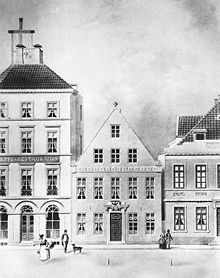Optical telegraph line Bremen – Bremerhaven
The optical telegraph line Bremen – Bremerhaven was a communication link between Bremerhaven , Brake and Bremen operated by Johann Ludwig Schmidt from 1847 to 1852 . The semaphore line at that time was based on the observation and dissemination of characters that have been displayed at signal mast.
requirement
At the beginning of the 1840s, news of a ship entering the Weser estuary to Brake and Bremen could only be reported by land messenger. Printed ship notification slips distributed these reports to subscribers. The news of the increasingly uncertain and unpredictable arrival of certain ships was of the greatest interest for the insurer, the shipowner, but also for the entire Bremen trading market. Its topicality was worth money because it allowed logistical arrangements and arrangements for subsequent business. The Bremen-based merchants and emigration agencies waited not only to hear which ship was sailing up the Weser, but also to find out what it had loaded, whether it was under quarantine , had sick people on board and how many men were needed to unload the cargo.
history
The establishment of the optical telegraph line Bremen – Bremerhaven was based on an initiative of the entrepreneur Johann Ludwig Schmidt from Altona , who after the construction of a corresponding connection between Altona and Cuxhaven (1838) had been looking for a concession and the establishment of a stock company for Bremen since 1837 had tried to build a line between Bremerhaven and Bremen and its connection to the Cuxhaven line. A quick realization failed because of the resistance of Hanover , which lasted until 1843. On the other hand, it was very much in the economic interests of Oldenburg , which wanted to direct traffic on the Unterweser to Brake and divert it from Bremen. This was done by building a separate telegraph tower on the quay of this Oldenburg port city and receiving an ongoing subsidy for operating costs. On July 13, 1846, the Bremerhaven – Brake section began operation, and it was not completed until January 1, 1847, to Bremen. The license was granted to a stock corporation from Bremen merchants, the Bremer Telegraphen Verein .
The optical telegraph line Bremen – Bremerhaven was already out of date at the moment it was put into operation, because on the exact same day the electrical telegraph line Bremen – Bremerhaven went into operation as the first longer electrical telegraph line within Europe. She worked with pointer telegraphs and made the optical line superfluous within a very short time. The technical (restrictions at night, fog, poor visibility) and economic disadvantages (high personnel costs) had become too great. In 1849 Schmidt filed for bankruptcy, and in 1852 the last, poorly working section of Bremerhaven – Brake ceased operations.
The companies in Hamburg and Bremen differed from the other optical telegraphs of their time in their intended purpose: Established with private capital and almost exclusively at the service of the merchants, they played a completely different role than the military and administrative systems in the territorial states of Prussia and Germany France.
Operation and establishment
Cross-shaped signal masts were mounted on church towers or purpose-built buildings along the approximately 70-kilometer route between Bremerhaven and Bremen, each of which had three free arms with a rotating wing that could be operated using a cable that could take up eight different positions. From the (theoretically 512) different positions, a limited number was selected for the alphabet and some special characters. These signals were observed with telescopes and passed on from the nearest station, a good ten kilometers away. The most famous of the telegraph stations today is the telegraph building in Brake an der Unterweser, the exterior of which has been preserved in almost its original condition and the signal system has been reconstructed.
The stations on the Weser line were: Bremerhaven (barrel yard), Dedesdorf (wooden tower), Brake, Elsfleth, Rekum, Vorbrock (Vorbruch-Bockhorn, signal tower), Vegesack (church), Oslebshausen (Adelenstift) and Bremen (at Domshof 16) . The Bremerhaven – Elmlohe – Bederkesa – Lamstedt cross-connection established in 1846 met the Elbe line at Hechthausen. Presumably in 1848 a branch was made in a northerly direction to Wremen .
literature
- Hans Harry von Chamier Glisczinski: The Telegraph in Bremen . In: Postal history sheets Weser-Ems . 1976, p. 188-192 .
- Alfred Löhr: Electrical communications engineering . In: Jörn Christiansen (Ed.): Bremen will be bright . Hauschild, Bremen 1993, p. 301-303 .
- Hartmut Roder : Bremen overseas merchants as promoters and beneficiaries of the "need for uninterrupted communication" . In: Hartmut Roder (Ed.): Bremen trading city on the river . Hauschild, Bremen 1995, p. 134-136 .
Individual evidence
- ↑ D. Box: 100 years of the Hamburg Telegraph Office . 1968
- ^ Fröbelschule Delmenhorst: The tender for the construction of the Braker Telegraph. In: Optical telegraphy on the Weser in the middle of the 19th century. Technical Atlas of Lower Saxony, 2002, accessed on September 26, 2010 .
- ↑ It is said to have been put into operation again from 1854 to 1855. (Glisczinski, see literature, p. 192)
- ↑ The sequence of stations given here follows a map of the course of the line from the Hamburg State Archives, which is shown in Chamier Glisczinski (see lit.) p. 189


